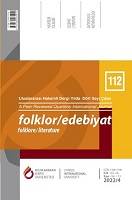Nazlı Eray’ın Kayıp Gölgeler Kenti ile Philip Kerr’in Ölümcül Prag Eserlerindeki Prag Görünümleri
The Portrayals of Prague in Nazlı Eray’s The City of Lost Shadows and Philip Kerr’s Prague Fatale Novels
Author(s): Fulya Çelik ÖzkanSubject(s): Turkish Literature, Sociology of Culture, Sociology of the arts, business, education, Theory of Literature, British Literature, Sociology of Literature
Published by: Uluslararası Kıbrıs Üniversitesi
Keywords: The City of Lost Shadows; Prague fatale; Prague; fantastic; detective; space;
Summary/Abstract: Based on all fictional texts, space takes place in different dimensions. When it comes to novels containing fantastical elements, they tend to put the perception of time and real life places into the background or completely change them. In fantastic narrative universe where dreams and reality are intertwined, the reader embarks on an unlimited journey between (real-unreal) spaces and (realunrealistic) times. Space also influences time by taking on different identities in every stage of the text. In novels with no fantastic elements, the author mostly prefers a direct narrative instead of giving the reader a surreal sense of time and place. Although these two approaches are different, space is indispensable for associating the novel’s characters with the place where the plot takes place. When space, which is a fundamental element in revealing meaning as a series of relations, is considered together with time, a variable and magical perception emerges in fantasy novels; however, in novels where reality is at the forefront, and there is an emphasis on event transfer, one does not go beyond a straight perception of time and space. In this context, the appearance of Prague in Nazlı Eray’s The City of Lost Shadows, who fictionalizes her works with fantastic elements in our literature, and the city’s identity in Philip Kerr’s detective novel Prague Fatale have been comparatively examined in terms of space. The themes of death and captivity arising from the gloomy history of the city, seen in both works, have been discussed in the context of temporal and spatial relations. Although the novels considered differ in perception and handling of the space, it has been observed that they meet in the themes of death and captivity in the axis of Prague.
Journal: Folklor/Edebiyat
- Issue Year: 28/2022
- Issue No: 112
- Page Range: 1085-1098
- Page Count: 14
- Language: Turkish

